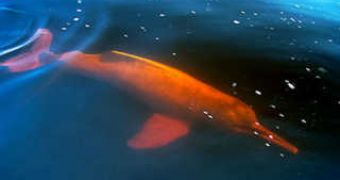Nowadays, it seems obvious that human intervention puts thousands of species of plants and animals in danger. We might be able to justify actions such as deforestation or a long list of industrial processes that are polluting the atmosphere throughout their list of benefits.
One might find a difficult time in making up excuses to justify the behavior of fishermen who are putting in danger the lives of Pink dolphins, for just some extra dollars.
The Pink dolphins are considered one of the most remarcable creatures that populate the waters of the Amazon River.
But their charm apparently doesn't work in their favor. For decades, fisherman have treated them as competitors for food and killed them in order to use them as bait.
Every year, the population of dolphins decreases by up to 10% every year. This phenomenon is a consequence of the fact that villagers don't seem to stop poaching them, even after several campaigns were organized, in order to raise the level of awareness regarding this matter.
The issue is significant since biologists have established that poachers have increased their activity recently, being able to act even more efficiently. The result is represented by the fact that 3 thousand dolphins face their death in villagers' nets.
The number is alarming since at this point in time scientists from the National Institute of Amazonian Research (INPA) have concluded that the ecosystem's population doesn't sum up more than 30 thousand animals.
In an attempt of taking matters into their own hands, several organizations which are concerned about the present situation are going to Brazil. There they will focus on developing measures which should prevent the slaughter of endangered species.
Also, non-profit organizations have expressed their disappointment regarding the measures taken by the government to put an end to this crisis, which turned out to be inefficient.
"This dolphin native to our region has been cruelly slaughtered for use as bait in fishing for catfish, like piracatinga. It is for this reason we want to establish a process that results in the development of effective action to eliminate this cruel and unsustainable activity in the region," stated Vera da Silva, from INPA.
Unless the government manages to come up with effective regulations that will fix this issue, the rate of decline in dolphin population will most likely increase from 7%, where we stand now.

 14 DAY TRIAL //
14 DAY TRIAL //